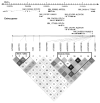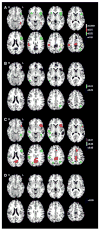Variants in the DYX2 locus are associated with altered brain activation in reading-related brain regions in subjects with reading disability
- PMID: 22750057
- PMCID: PMC3518451
- DOI: 10.1016/j.neuroimage.2012.06.037
Variants in the DYX2 locus are associated with altered brain activation in reading-related brain regions in subjects with reading disability
Abstract
Reading disability (RD) is a complex genetic disorder with unknown etiology. Genes on chromosome 6p22, including DCDC2, KIAA0319, and TTRAP, have been identified as RD associated genes. Imaging studies have shown both functional and structural differences between brains of individuals with and without RD. There are limited association studies performed between RD genes, specifically genes on 6p22, and regional brain activation during reading tasks. Using fourteen variants in DCDC2, KIAA0319, and TTRAP and exhaustive reading measures, we first tested for association with reading performance in 82 parent-offspring families (326 individuals). Next, we determined the association of these variants with activation of sixteen brain regions of interest during four functional magnetic resonance imaging-reading tasks. We nominally replicated associations between reading performance and variants of DCDC2 and KIAA0319. Furthermore, we observed a number of associations with brain activation patterns during imaging-reading tasks with all three genes. The strongest association occurred between activation of the left anterior inferior parietal lobe and complex tandem repeat BV677278 in DCDC2 (uncorrected p=0.00003, q=0.0442). Our results show that activation patterns across regions of interest in the brain are influenced by variants in the DYX2 locus. The combination of genetic and functional imaging data show a link between genes and brain functioning during reading tasks in subjects with RD. This study highlights the many advantages of imaging data as an endophenotype for discerning genetic risk factors for RD and other communication disorders and underscores the importance of integrating neurocognitive, imaging, and genetic data in future investigations.
Copyright © 2012 Elsevier Inc. All rights reserved.
Conflict of interest statement
Yale University has applied for a patent covering the complex tandem repeat and deletion in BV677278 (inventors: JRG and HM), and sublicensed it to JS Genetics, Inc. JRG is a founder and equity holder of JS Genetics, Inc. KH is currently employed by JS Genetics, Inc. NC, JDE, CJG, CL, RKF, RTC, and GPP each reported no biomedical financial interests or potential conflicts of interest.
Figures


Similar articles
-
Characterization of the DYX2 locus on chromosome 6p22 with reading disability, language impairment, and IQ.Hum Genet. 2014 Jul;133(7):869-81. doi: 10.1007/s00439-014-1427-3. Epub 2014 Feb 9. Hum Genet. 2014. PMID: 24509779 Free PMC article.
-
DCDC2, KIAA0319 and CMIP are associated with reading-related traits.Biol Psychiatry. 2011 Aug 1;70(3):237-45. doi: 10.1016/j.biopsych.2011.02.005. Epub 2011 Mar 31. Biol Psychiatry. 2011. PMID: 21457949 Free PMC article.
-
Investigation of interaction between DCDC2 and KIAA0319 in a large German dyslexia sample.J Neural Transm (Vienna). 2008 Nov;115(11):1587-9. doi: 10.1007/s00702-008-0124-6. Epub 2008 Sep 23. J Neural Transm (Vienna). 2008. PMID: 18810304
-
Breakthroughs in the search for dyslexia candidate genes.Trends Mol Med. 2006 Jul;12(7):333-41. doi: 10.1016/j.molmed.2006.05.007. Epub 2006 Jun 16. Trends Mol Med. 2006. PMID: 16781891 Review.
-
The genetics of reading disability.Curr Psychiatry Rep. 2009 Apr;11(2):149-55. doi: 10.1007/s11920-009-0023-z. Curr Psychiatry Rep. 2009. PMID: 19302769 Review.
Cited by
-
Imaging-genetics in dyslexia: connecting risk genetic variants to brain neuroimaging and ultimately to reading impairments.Mol Genet Metab. 2013 Nov;110(3):201-12. doi: 10.1016/j.ymgme.2013.07.001. Epub 2013 Jul 17. Mol Genet Metab. 2013. PMID: 23916419 Free PMC article. Review.
-
A molecular-genetic and imaging-genetic approach to specific comprehension difficulties in children.NPJ Sci Learn. 2018 Nov 21;3:20. doi: 10.1038/s41539-018-0034-9. eCollection 2018. NPJ Sci Learn. 2018. PMID: 30631481 Free PMC article.
-
Putative protective neural mechanisms in prereaders with a family history of dyslexia who subsequently develop typical reading skills.Hum Brain Mapp. 2020 Jul;41(10):2827-2845. doi: 10.1002/hbm.24980. Epub 2020 Mar 13. Hum Brain Mapp. 2020. PMID: 32166830 Free PMC article.
-
Neuroimaging genetics studies of specific reading disability and developmental language disorder: A review.Lang Linguist Compass. 2019 Sep;13(9):e12349. doi: 10.1111/lnc3.12349. Epub 2019 Sep 5. Lang Linguist Compass. 2019. PMID: 31844423 Free PMC article.
-
The Influence of Dyslexia Candidate Genes on Reading Skill in Old Age.Behav Genet. 2018 Sep;48(5):351-360. doi: 10.1007/s10519-018-9913-3. Epub 2018 Jun 29. Behav Genet. 2018. PMID: 29959602 Free PMC article.
References
-
- Beaulieu C, Plewes C, Paulson LA, Roy D, Snook L, Concha L, Phillips L. Imaging brain connectivity in children with diverse reading ability. Neuroimage. 2005;25:1266–1271. - PubMed
-
- Benjamini Y, Hochberg Y. Controlling the false discovery rate: a practical and powerful approach to multiple testing. J R Statst Soc B. 1995;57(1):289–300.
-
- Brambati SM, Termine C, Ruffino M, Stella G, Fazio F, Cappa SF, Perani D. Regional reductions of gray matter volume in familial dyslexia. Neurology. 2004;63:742–745. - PubMed
-
- Brown WE, Eliez S, Menon V, Rumsey JM, White CD, Reiss AL. Preliminary evidence of widespread morphological variations of the brain in dyslexia. Neurology. 2001;56:781–783. - PubMed
-
- Brunswick N, McCrory E, Price CJ, Frith CD, Frith U. Explicit and implicit processing of words and pseudowords by adult developmental dyslexics: A search for Wernicke’s Wortschatz? Brain. 1999;122(Pt 10):1901–1917. - PubMed
Publication types
MeSH terms
Substances
Grants and funding
LinkOut - more resources
Full Text Sources
Other Literature Sources
Research Materials
Miscellaneous

